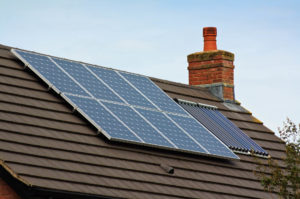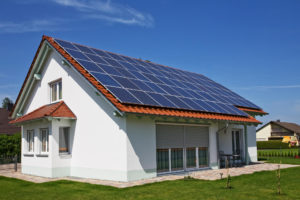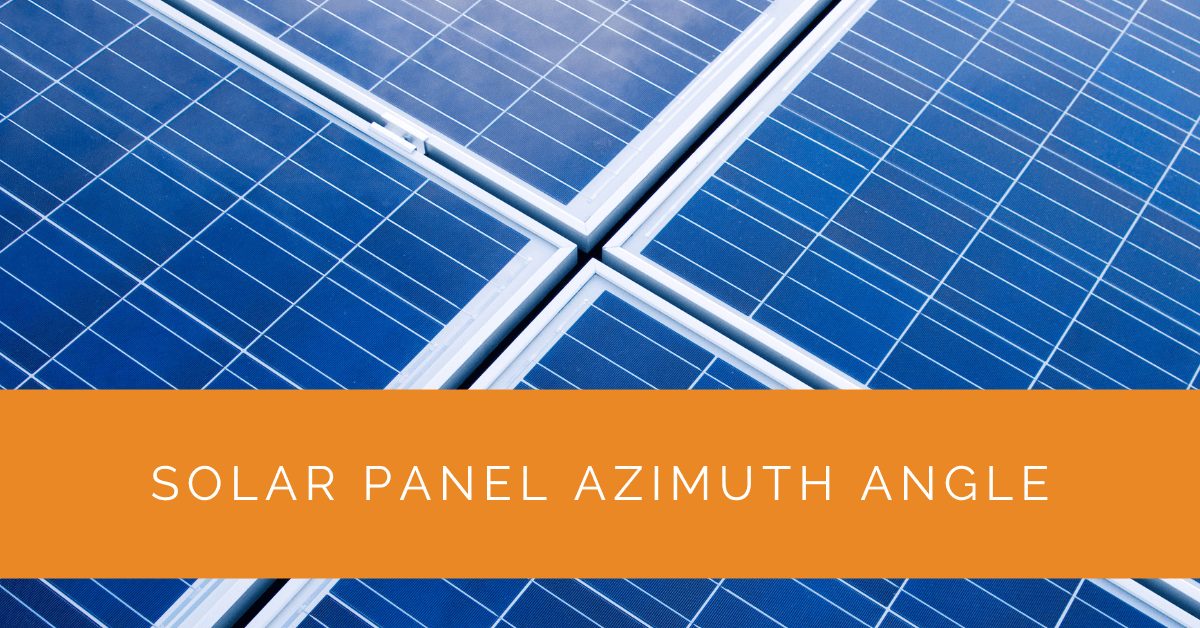Solar panels are the backbone of renewable energy generation, revolutionizing how we harness power from the sun. However, unlocking their full potential requires a nuanced understanding of solar panel orientation, and at the heart of this is the solar panel azimuth angle. In this comprehensive guide, we will delve deeply into the intricacies of azimuth angles and how they shape the efficiency of your solar energy system.
Contents
- 1 Key Takeaways
- 2 Solar Panel Orientation
- 3 What is Azimuth Angle?
- 4 Finding the Optimal Azimuth Angle
- 5 Tilt Angle vs. Azimuth Angle
- 6 Seasonal Adjustments
- 7 Solar Panel Tracking Systems
- 8 Sizing Your Solar Panel System
- 9 Environmental Considerations
- 10 Case Study: Optimizing Solar Panel Azimuth Angles for Maximum Efficiency
- 11 Expert Insights From Our Solar Panel Installers About Understanding Solar Panel Azimuth Angle
- 12 Experience Solar Excellence with Us!
- 13 Conclusion
Key Takeaways
- The azimuth angle, crucial for solar panel orientation, significantly affects energy production and should be adjusted seasonally for optimal performance.
- Calculating the ideal azimuth angle involves considering factors like latitude, magnetic declination, and the sun’s path while balancing it with the tilt angle.
- Solar panel tracking systems and proper system sizing further enhance efficiency, contributing to both solar energy’s financial and environmental benefits.
Solar Panel Orientation
Before we dive into azimuth angles, let’s underscore the critical importance of solar panel orientation. Solar panels are meticulously engineered to effectively capture sunlight and convert it into electricity. This efficiency hinges on two essential aspects: the direction the panels face (azimuth angle) and the vertical tilt angle.
What is Azimuth Angle?
Definition and Significance
The azimuth angle, or the solar panel azimuth, defines the compass direction your solar panels face. This angle is pivotal in determining the quantity of sunlight your panels receive throughout the day. Typically measured in degrees clockwise from true south (in the Northern Hemisphere) or true north (in the Southern Hemisphere), the azimuth angle determines the horizontal orientation of your solar panels.
Impact on Solar Energy Output
Understanding the impact of azimuth angle on solar energy output is paramount. In the Northern Hemisphere, the optimal azimuth angle generally points towards true south, while in the Southern Hemisphere, it aligns with true north. Deviating from this optimal azimuth angle can reduce energy production, as the panels may not efficiently capture sunlight.

Finding the Optimal Azimuth Angle
Several factors come into play when determining the optimal azimuth angle for your solar panels. These factors encompass your geographical location, latitude, and the time of year. Latitude is a key determinant, with regions closer to the equator typically requiring solar panels to face either true south or true north to maximize energy capture.
Calculating the Optimal Azimuth Angle
You can utilize solar calculators or manual calculation methods to calculate the optimal azimuth angle for your specific location. These calculations consider factors such as your location’s latitude, magnetic declination, and the sun’s path throughout the year.
Solar Calculators
Online solar calculators offer a convenient way to determine the optimal azimuth angle for your solar panels. These tools consider your location, roof orientation, and expected energy output, providing precise recommendations tailored to your setup.
Manual Calculation
Manual calculations can be performed using a compass and basic trigonometry for those who prefer a hands-on approach. You can determine the optimal azimuth angle by accounting for magnetic declination (the angle difference between true north and magnetic north) and the sun’s position throughout the day.
Tilt Angle vs. Azimuth Angle
While the azimuth angle focuses on the horizontal direction your panels face, the tilt angle pertains to the vertical orientation. These two angles collaborate to optimize solar energy generation.
Balancing Act
Achieving the perfect balance between tilt and azimuth angles is essential. The tilt angle ensures that your panels receive sunlight optimally throughout the day by adjusting their angle relative to the sun’s position in the sky. Meanwhile, the azimuth angle directs them horizontally toward the sun’s path.
Seasonal Adjustments
As the seasons change, so does the sun’s angle in the sky. To maximize energy production year-round, it’s essential to make seasonal adjustments to your solar panel azimuth angle.
Winter Adjustments
When the sun is lower in winter, adjusting your panels to a slightly steeper azimuth angle is advisable to capture more sunlight. This compensates for the reduced angle of the sun’s rays during the colder months.
Summer Adjustments
Conversely, when the sun is higher in the summer, adjusting your panels to a slightly shallower azimuth angle can prevent overheating and ensure optimal energy production.

Solar Panel Tracking Systems
Solar panel tracking systems represent an advanced approach to azimuth angle optimization. These systems automatically adjust the panels’ orientation throughout the day to follow the sun’s path, maximizing energy generation. They come in two primary types: single-axis and dual-axis trackers.
Benefits and Considerations
While solar tracking systems can significantly boost energy production, they come with installation and maintenance costs. It’s crucial to weigh these factors against the increased output when deciding whether to implement tracking. Fixed-tilt systems are often sufficient for residential installations while tracking systems are more commonly used in larger-scale projects.
Sizing Your Solar Panel System
The size of your solar panel system can also influence the optimal azimuth angle. Larger systems may require a more precise orientation to maximize energy capture, as their energy production potential is higher.
Tailoring Your System
Consult a professional installer to ensure your solar system is tailored to your azimuth angle and energy needs. They can help you determine the ideal system size and orientation. The installer will consider the available roof space, local climate conditions, and electricity consumption patterns to design the most efficient system for your needs.
Environmental Considerations
Beyond energy efficiency, the azimuth angle of your solar panels can have environmental implications. Utilizing solar energy reduces greenhouse gas emissions and lessens your carbon footprint. By optimizing your azimuth angle and making seasonal adjustments, you can contribute to a cleaner and more sustainable planet.
Case Study: Optimizing Solar Panel Azimuth Angles for Maximum Efficiency
Background
Solar Panels Network USA partnered with a commercial facility in Texas to optimize their solar panel installation. The goal was to enhance the energy output by fine-tuning the azimuth angle, ensuring the system operated at peak efficiency throughout the year.
Project Overview
The commercial facility had a substantial solar panel array installed on its rooftop. However, the energy output varied significantly across seasons. Our task was to adjust the azimuth angle and improve the overall efficiency of the solar energy system, providing consistent power generation.
Implementation
Initial Assessment
We began by assessing the current setup, measuring the existing azimuth and tilt angles. Using solar calculators and manual calculations, we determined the optimal azimuth angle for the facility’s geographical location, considering factors like latitude, magnetic declination, and the sun’s path.
Adjusting the Azimuth Angle
The solar panels were initially set at a standard azimuth angle, not optimized for the facility’s specific location and seasonal sunlight variations. We adjusted the azimuth angle to point true south, aligning the panels for maximum sunlight exposure in the Northern Hemisphere.
Seasonal Adjustments
We also implemented a plan for seasonal adjustments. During winter, the panels were adjusted to a steeper azimuth angle to capture the lower sun angle. Conversely, in summer, the panels were adjusted to a shallower angle to prevent overheating and optimize energy production.
Installing a Solar Tracking System
For continuous optimization, we recommended and installed a single-axis solar tracking system. This system automatically adjusted the azimuth angle throughout the day, following the sun’s path and maximizing sunlight capture. The tracking system ensured optimal performance without manual adjustments.
Results
The adjustments resulted in a noticeable increase in energy production. The facility reported a 15% improvement in energy output during winter and a 10% increase in summer, thanks to the optimized azimuth angle and seasonal adjustments. The solar tracking system further enhanced efficiency, providing a consistent power supply and reducing reliance on grid electricity.
Summary
This case study highlights the importance of optimizing the azimuth angle for solar panel installations. By fine-tuning the azimuth angle and making seasonal adjustments, Solar Panels Network USA significantly improved the energy efficiency of a commercial facility’s solar array. The installation of a solar tracking system further ensured optimal performance, demonstrating the value of continuous optimization in solar energy systems.
Optimizing the azimuth angle is crucial for maximizing energy production and ensuring a sustainable and efficient solar energy system. With the right adjustments and continuous monitoring, solar panels can operate at peak efficiency, providing substantial energy savings and environmental benefits. Solar Panels Network USA remains committed to delivering tailored, high-quality solar solutions that meet the unique needs of our clients, promoting a greener and more sustainable future.
Expert Insights From Our Solar Panel Installers About Understanding Solar Panel Azimuth Angle
Optimizing the azimuth angle of your solar panels is crucial for maximizing energy production. Small adjustments can significantly impact the efficiency of your solar energy system, especially in regions with varied seasonal sunlight.
Senior Solar Installer
Combining the right tilt and azimuth angles can drastically improve your solar panel’s performance. Balancing these two aspects ensures that your panels capture the maximum amount of sunlight throughout the year.
Lead Solar Technician
Investing in a solar tracking system can provide significant energy gains. These systems continuously adjust the azimuth and tilt angles, ensuring optimal sunlight capture from dawn till dusk.
Solar Installation Expert
Experience Solar Excellence with Us!
Trust in Solar Panels Network USA, where our seasoned experts deliver top-quality solar solutions for homes and businesses nationwide. With a legacy of countless successful installations and a commitment to sustainable energy, we’re your reliable partner in the solar journey. Ready for a brighter, eco-friendly future? Call us now at (855) 427-0058 and harness the power of the sun!
Conclusion
Understanding the solar panel azimuth angle is about maximizing energy production and embracing a greener, more sustainable future. By finding the optimal azimuth angle, either through sophisticated calculations or the help of user-friendly solar calculators, and making seasonal adjustments to adapt to changing sun angles, you can significantly increase your electricity generation while reducing your impact on the environment.
The azimuth angle serves as the compass that guides your solar panels to capture abundant sunlight, ultimately translating into substantial energy savings and a greener planet. Properly aligning your solar panels is both environmentally friendly and financially rewarding, as it maximizes the return on your solar investment. Invest time optimizing your solar panel azimuth angle, and you’ll reap the benefits of clean, efficient, and sustainable energy generation for years. Embrace the sun’s power and positively impact your energy bills and the world around you.
About the Author
Solar Panels Network USA stands at the forefront of solar energy solutions, driven by a team of seasoned solar engineers and energy consultants. With over decades of experience in delivering high-quality solar installations and maintenance, we are committed to promoting sustainable energy through customer-centric, tailored solutions. Our articles reflect this commitment, crafted collaboratively by experts to provide accurate, up-to-date insights into solar technology, ensuring our readers are well-informed and empowered in their solar energy decisions.

